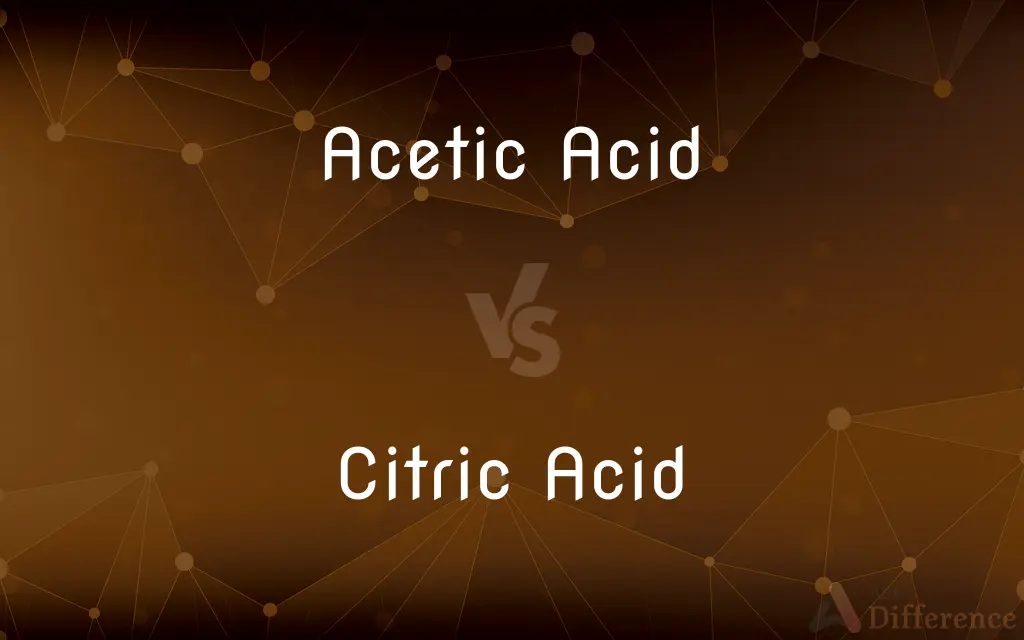Acetic Acid vs. Citric Acid — What's the Difference?
By Tayyaba Rehman — Published on January 10, 2024
Acetic Acid is a two-carbon acid found in vinegar; Citric Acid is a three-carbon acid present in citrus fruits.

Difference Between Acetic Acid and Citric Acid
Table of Contents
ADVERTISEMENT
Key Differences
Acetic Acid is a simple carboxylic acid, known for its pungent smell and sour taste, commonly found in vinegar. It is the primary component that gives vinegar its characteristic flavor. As an organic compound, Acetic Acid has a molecular formula of CH₃COOH, and its structure features a single carboxylic acid group.
Citric Acid, in contrast, is a weak organic acid predominantly found in citrus fruits such as lemons, oranges, and grapefruits. It is a tricarboxylic acid with the molecular formula C₆H₈O₇. Due to the presence of three carboxylic acid groups, Citric Acid is more complex than Acetic Acid. Citric Acid plays a crucial role in the citric acid cycle, a central metabolic pathway in all aerobic organisms.
Acetic Acid is commonly utilized as a food preservative, condiment, and for its acidic properties in various chemical processes. In addition, its antimicrobial properties make it a valuable agent for food preservation. Industrially, Acetic Acid is used in the production of synthetic fibers and plastics.
Citric Acid has multiple roles in food and beverages. It acts as a preservative, flavoring agent, and is vital in setting the color of canned fruits. Additionally, it's used in cleaning products due to its ability to chelate metals and act as a descaling agent. In the pharmaceutical industry, Citric Acid aids in making effervescent tablets.
In essence, while both Acetic Acid and Citric Acid are organic acids used in foods and other applications, their chemical structures, sources, and roles differ significantly.
ADVERTISEMENT
Comparison Chart
Source
Vinegar
Citrus fruits
Molecular Formula
CH₃COOH
C₆H₈O₇
Carboxylic Acid Groups
One
Three
Common Uses
Food preservative, condiment
Flavoring agent, preservative, cleaning
Taste
Sour
Sour with a hint of sweetness
Compare with Definitions
Acetic Acid
Acetic Acid has a pungent smell and sour taste.
The strong aroma from vinegar is due to the presence of Acetic Acid.
Citric Acid
Citric Acid can act as a descaling agent in cleaning.
The build-up of lime scale in kettles can be removed using Citric Acid.
Acetic Acid
Acetic Acid is a simple organic acid found in vinegar.
The sour taste of vinegar is primarily due to Acetic Acid.
Citric Acid
Citric Acid plays a role in the citric acid cycle in metabolism.
The citric acid cycle is essential for producing energy in cells, with Citric Acid as a key component.
Acetic Acid
Acetic Acid has the molecular formula CH₃COOH.
Acetic Acid's structure consists of a methyl group attached to a carboxyl group.
Citric Acid
Citric Acid has the molecular formula C₆H₈O₇.
Citric Acid is a tricarboxylic acid, having three carboxylic acid groups.
Acetic Acid
Acetic Acid is commonly used as a food preservative.
Pickles are often preserved using Acetic Acid, which prevents bacterial growth.
Citric Acid
Citric Acid is commonly used as a flavoring and preservative agent.
Citric Acid is added to candies for a tangy flavor and to prevent spoilage.
Acetic Acid
Acetic Acid is produced industrially through bacterial fermentation.
The fermentation of ethanol by bacteria yields Acetic Acid.
Citric Acid
Citric Acid is a weak organic acid found in citrus fruits.
Lemons and oranges are rich in Citric Acid, giving them a tart flavor.
Common Curiosities
Where is Acetic Acid commonly found?
Acetic Acid is the main component of vinegar, giving it its sour taste.
What are the industrial uses of Acetic Acid?
Acetic Acid is used in producing synthetic fibers, plastics, and as a food preservative.
What is Acetic Acid?
Acetic Acid is a simple organic acid primarily found in vinegar.
How is Acetic Acid produced?
Acetic Acid can be produced industrially through bacterial fermentation of ethanol.
What is Citric Acid?
Citric Acid is a weak organic acid predominantly present in citrus fruits.
How is Citric Acid produced?
While Citric Acid can be extracted from fruits, it is industrially produced using mold fermentation.
Where is Citric Acid commonly found?
Citric Acid is abundant in citrus fruits like lemons, oranges, and grapefruits.
Why is Citric Acid used in food?
Citric Acid acts as a preservative, flavoring agent, and can set the color of canned fruits.
Is Acetic Acid stronger than Citric Acid?
In terms of acidity, Acetic Acid is generally stronger than Citric Acid.
How does Citric Acid taste?
Citric Acid has a sour taste with a hint of sweetness.
Can Citric Acid be used for cleaning?
Yes, Citric Acid can be used as a descaling agent due to its chelating properties.
How does Acetic Acid taste?
Acetic Acid has a distinctly sour taste.
Share Your Discovery

Previous Comparison
Linear Equations vs. Nonlinear Equations
Next Comparison
Prokaryotic DNA Replication vs. Eukaryotic DNA ReplicationAuthor Spotlight
Written by
Tayyaba RehmanTayyaba Rehman is a distinguished writer, currently serving as a primary contributor to askdifference.com. As a researcher in semantics and etymology, Tayyaba's passion for the complexity of languages and their distinctions has found a perfect home on the platform. Tayyaba delves into the intricacies of language, distinguishing between commonly confused words and phrases, thereby providing clarity for readers worldwide.












































